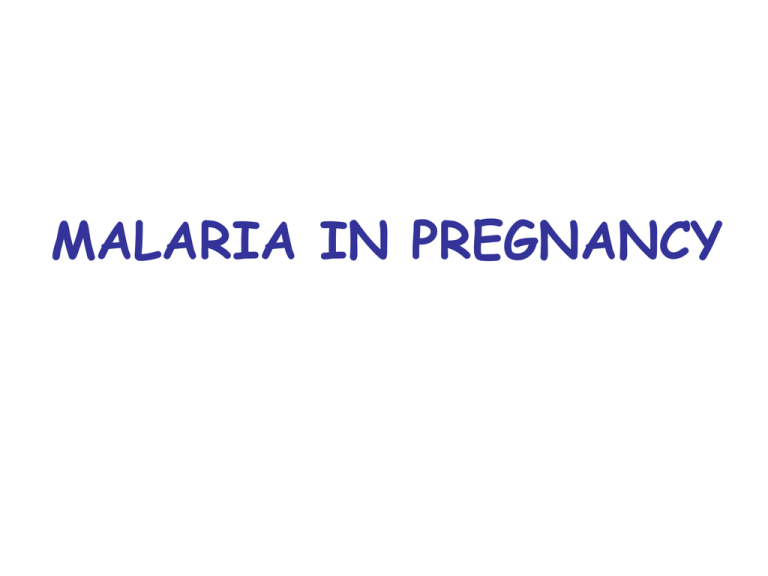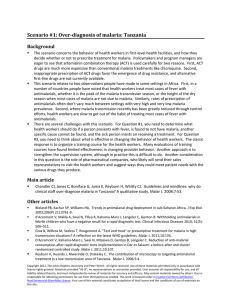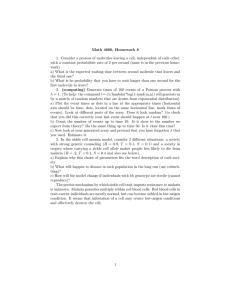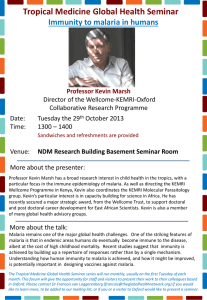MALARIA IN PREGNANCY
advertisement

MALARIA IN PREGNANCY I. OBJECTIVES At the end of the session you should be able to: 1. Outline the causes of malaria in pregnancy 2. Outline clinical features of malaria in pregnancy, 3. Describe maternal and fetal effects of malaria in pregnancy 4. Describe the maternal fetal immunity for malaria in pregnancy, 5. Describe treatment of malaria in pregnancy and lactating mothers 6. Describe the WHO package for the prevention and control of malaria during pregnancy II. BACKGROUND • Burden of the disease: – 2 billion people affected worldwide. – 1-2.5 million deaths annually (mostly pregnant women, infants 0-5 years and HIV patients). • Greatest challenge today is Resistance to Drugs – Incidences have risen in recent years, probably due to increasing resistance to antimalarial medicines. III. CAUSES OF MALARIA • Protozoa: – Genus: Plasmodium. – Species that infect humans are –P. falciparum, –P. vivax, –P. ovale and –P. malariae. • Vector: Female anopheline mosquito • Occasional infections with monkey malaria parasites, such as P. knowlesi, also occur. IV. CLINICAL FEATURES I. Uncomplicated malaria • Clinical features include: – Headache, lassitude, fatigue, abdominal discomfort and muscle and joint aches, – Followed by fever, chills, anorexia, vomiting and worsening malaise. • Infection with P. vivax and P. ovale, more than with other species, can be associated with welldefined malarial paroxysms, in which: – Fever spikes, chills and rigors occur at regular intervals. CLINICAL FEATURES cont II. Severe/complicated malaria One or more of the following criteria + the presence of asexual parasitaemia defines severe malaria. • Cerebral malaria/ unarousable coma – at least for 30min • Metabolic acidosis: – Arterial pH < 7.25 or plasma bicarbonate level of < 15 mmol/l or Venous lactate level of > 15 mol/l. • Severe haemolytic anaemia/black water fever – Usually is normocytic normochromic anaemia. CLINICAL FEATURES: complicated malaria cont • Hypoglycaemia – RBG < 40 mg/dl (2.2 mmol / l • Acute renal failure • Pulmonary oedema / adult respiratory distress syndrome • Disseminated intravascular coagulation (DIC), • Hypotension – 2°bacterial infections may → septicaemic shock • Convulsions NOTE: If untreated, severe malaria is almost always fatal. Other manifestations of severe malaria, which do not by themselves define the condition • Impairment of consciousness less marked than unarousable coma. • Prostration and weakness – Patient cannot sit or walk with no obvious neurological explanation. • Hyperparasitaemia: • Hyperpyrexia: – Rectal temperature above 40° C (104° F) in adults and children. V. MATERNAL EFFECTS OF MALARIA 1. Anaemia in pregnancy • More common and severe young primigravidae • Starts in mid trimester btn 16 – 24 th weeks of GA Mechanisms: a. Haemolysis and sequestration of infected RBCs into the RES. b. Haemolysis of non-parasitized RBCs Non-parasitized RBCs may be may be opsonized and develop auto-antibodies that make them prone to haemolysis. Such opsonized RBCs are sequestrated into the spleen and removed from circulation by lympho-macrophages Malarial anaemia in pregnancy cont c. Bone marrow suppression and dyserythropoiesis (ineffective erythropoiesis): • Tumor necrosis factor (TNF) is thought to mediate bone marrow suppression by inducing dyserythropoiesis and reducing erythroid proliferation. d. Loss of appetite VI. FETAL EFFECTS OF MALARIA 1. Pyrexia is associated with – Induction of uterine contractions leading to Abortions, preterm labour, – IUFD and fetal distress. 2. Placental Parasitization: • Presents with clogging of the intervillous spaces with macrophages (Placental Reaction), which is most marked during the second half of pregnancy: • Ultimate effect of placental parasitization: – IUGR, LBW, IUFD, SB VII. IMMUNITY IN ENDEMIC AREAS 1. Maternal immunity • Generally, immunity declines in pregnancy – Probably due to increased levels of cortisol, hence increased susceptibility to falciparum malaria in pregnancy • Immunity for malaria decrease is more marked in primes and younger women particularly in the third trimester, than in multips and older women. 2. Fetal immunity in endemic areas Protective mechanisms of the fetus in utero a. Immune mother transmit passive immunity (antimalarial IgG) to the fetus. The few parasites that succeed are destroyed by the antimalarial IgG b. The placenta greatly limits the number of parasites gaining access into the fetal circulation. c. Falciparum parasites do not grow well in fetal RBC containing Hb F. Fetal immunity in endemic areas cont IMPORTANT NOTE: 1. These protective mechanisms wane after birth 2. In non endemic areas usually there is low maternal immunity, hence no protection against development of congenital anaemia. Therefore, such babies may be stillborn or suffer ENND VIII. DIAGNOSIS OF MALARIA 1. Importance – Help to reduce unnecessary use of antimalarials. – High specificity can reduce unnecessary treatment with antimalarials and improve differential diagnosis of febrile illness. 2. Methods • The diagnosis of malaria is based on: – Clinical diagnosis - has very low specificity – Detection of parasites in the blood. DIAGNOSIS OF MALARIA cont • If blood results are not readily available, – Weigh the risk of withholding antimalarial treatment against the risk associated with antimalarial treatment when given to a patient who does not have malaria • Methods in use for parasitological diagnosis i. Light microscopy Low cost, high sensitivity and specificity when used by well-trained staff. ii. Rapid diagnostic tests (RDTs) • Used to detection of parasite antigen DIAGNOSIS OF MALARIA cont • In areas of high stable malaria transmission, – Under fives should be treated on the basis of a clinical diagnosis. – A parasitological diagnosis is recommended before treatment is started in: • Older children and adults • Pregnancy • All suspected cases of severe malaria, • In the absence of or a delay in obtaining parasitological diagnosis, patients should be treated for severe malaria on clinical grounds. IX. RESISTANCE TO ANTIMALARIAL DRUGS • Resistance has arisen to all classes of antimalarials except, as yet, to the artemisinin derivatives. • Resistance can be prevented, or its onset slowed considerably, – By combining antimalarials with different mechanisms of action and ensuring very high cure rates through full adherence to correct dose regimens • Resistance to antimalarials has been documented for P. falciparum, P. vivax and, recently, P. malariae. RESISTANCE TO ANTIMALARIALS cont • In P. falciparum, resistance has been observed to almost all currently used antimalarials (amodiaquine, chloroquine, mefloquine, quinine and sulfadoxine–pyrimethamine) except for artemisinin and its derivatives. • The geographical distributions and rates of spread have varied considerably • Impact of resistance – Increased the global malaria burden and is a major threat to malaria control. X. ANTIMALARIALS IN PREGNANCY • No sufficient information on the safety and efficacy of most antimalarials in pregnancy, particularly for exposure in the first trimester, and so treatment recommendations are different to those for non-pregnant adults. ANTIMALARIALS IN PREGNANCY cont • The antimalarials considered safe in the first trimester of pregnancy are – Quinine, chloroquine, proguanil, pyrimethamine and sulfadoxine–pyrimethamine. • Of these, quinine remains the most effective and can be used in all trimesters of pregnancy including the first trimester. – Amodiaquine, chlorproguanil- dapsone, halofantrine, lumefantrine and piperaquine • Have not been evaluated sufficiently to permit positive recommendations. ANTIMALARIALS IN PREGNANCY cont – Sulfadoxine–pyrimethamine • Is safe but may be ineffective in many areas because of increasing resistance. – Primaquine and tetracyclines • Should not be used in pregnancy. NOTE: Despite these many uncertainties, effective treatment must not be delayed in pregnant women. XII. TREATMENT OF MALARIA IN PREGNANCY I. UNCOMPLICATED MALARIA • First trimester: – Quinine (orally) for 7 days. – ACT should be used if it is the only effective treatment available. • Second and third trimesters: – Artemether plus Lumefantrine (ALu) TREATMENT OF MALARIA IN PREGNANCY cont II. SEVERE MALARIA • Quinine 10 mg/kg body weight – Dilute in 5 – 10 ml/kg body weight of 5% Dextrose or dextrose saline – Infused over 4 hours and repeated every 8 hours Drop rate per minute = amount of fluid to be infused x 20 (drop factor) Time period to be infused (in minutes) • Discontinue infusions once the patient is able to take oral medication, alternatively a full course of Artemether plus Lumefantrine (ALu) should be for 7 days TREATMENT OF MALARIA IN PREGNANCY cont • Dilution of quinine for i.m – Dose: 10 mg/kg – Dilute four –times in water for injection or normal saline to a concentration of 60 mg/ml. This dilution minimizes the risk of abscess formation XIII. WHO package of interventions for the prevention and control of malaria during pregnancy 1. Use of insecticide treated nets (ITNs) to prevent infection 2. Intermittent Preventive Treatment (IPT) To prevent asymptomatic infections among pregnant women living in areas of moderate or high transmission of P. falciparum 3. Effective management and prevention of malaria illness and anaemia. XIV. INTERMITTENT PRESUMPTIVE TREATMENT Definition Is the administration of drug therapy in a full therapeutic doses at predetermined intervals during pregnancy even if individuals do not have symptoms or signs of malaria. Purposes Prevention of negative effects of malaria to the mother, foetus and newborn INTERMITTENT PRESUMPTIVE TREATMENT cont • Drug of choice: Sulfadoxine/pyrimethamine (SP) • Doses: 3 tablets twice during pegnancy • First dose: between 20 – 24 weeks • Second dose: between 28 – 32 weeks • Preferably given as DOT





